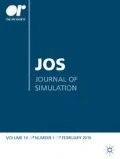Abstract
One of the critical success factors in a simulation project is good communication between different stakeholders in the project, especially in the early stages. Good documentation or representation is essential for communicating conceptual models between stakeholders effectively. Despite the lack of a single accepted definition for a conceptual model, most definitions agree that a conceptual model contains a set of components, each of which specifies different aspects of a conceptual model. This paper advocates the use of a standard multi-faceted representation of conceptual models. A number of diagrams are proposed to represent each of the conceptual model components. Our intention is to initiate discussion and the development of a standard multi-faceted conceptual model representation that will benefit stakeholders involved in a simulation project. A case study in healthcare is used to show how the proposed unified conceptual modelling representation can be applied in practice.










Similar content being viewed by others
References
Araujo WLF and Hirata CM (2004). Translating activity cycle diagrams to java simulation programs. In: Proceedings of the 37th Annual Simulation Symposium. IEEE: Piscataway, NJ, pp 157–164.
Banks J, Carson JS, Nelson BL and Nicol DM (2005). Discrete-Event System Simulation, 4th edn. Pearson Education: Upper Saddle River, NJ.
Brailsford SC, Lattimer VA, Tarnaras P and Turnbull JC (2004). Emergency and on-demand health care: Modelling a large complex system. J Opl Res Soc 55: 34–42.
Clemen RT and Reilly T (2005). Making Hard Decisions with DecisionTools®, 2nd edn. Duxbury, Thomson Learning: Belmont, CA.
Forrester J (1961). Industrial Dynamics. MIT Press: Cambridge, MA.
Gunal MM and Pidd M (2006). Understanding accident and emergency department performance using simulation. In: Perrone LF, Wieland FP, Liu J, Lawson BG, Nicol DM and Fujimoto RM (eds). Proceedings of the 2006 Winter Simulation Conference. IEEE Computer Society Press: Piscataway, NJ, pp 446–452.
Hills PR (1971). HOCUS. P-E Group: Egham, Surrey, UK.
Holloway CA (1979). Decision Making under Uncertainty: Models and Choices. Prentice-Hall: Englewood Cliffs, NJ.
Howard RA and Matheson JE (1984). Influence diagram. In: Howard RA and Matheson JE (eds). The Principles and Applications of Decision Analysis Vol. II. Strategic Decisions Group: Palo Alto, CA, pp 719–762.
Keeney RL (1992). Value-Focused Thinking. Harvard University Press: Cambridge, MA.
Kotiadis K (2007). Using soft systems methodology to determine the simulation study objectives. J Simul 1 (3): 215–222.
Nance RE (1994). The conical methodology and the evolution of simulation model development. Ann Opns Res 53: 1–45.
Pace DK (2000). Ideas about simulation conceptual model development. J Hopkins APL Tech Dig 21 (3): 327–336.
Pidd M (2004). Comput Simulat Mngt Sci, 5th edn. John Willey and Sons: Chichester, England.
Pidd M and Carvalho A (2006). Simulation software: Not the same yesterday, today or forever. J Simulat 1 (1): 7–20.
Pooley RJ (1991). Towards a standard for hierarchical process oriented discrete event simulation diagrams. Trans Soc Comput Simulat 8 (1): 1–20.
Richter H and Marz L (2000). Towards a standard process: The use of UML for designing simulation models. In: Joines JA, Barton RR, Kang K and Fishwick PA (eds). Proceedings of the Winter Simulation Conference. IEEE: Piscataway, NJ, pp 394–398.
Robinson S (2004). Simulation: The Practice of Model Development and Use. Wiley: Chichester, UK.
Robinson S (2006). Conceptual modelling for simulation: Issues and research requirements. In: Perrone LF, Wieland FP, Liu J, Lawson BG, Nicol DM and Fujimoto RM (eds). Proceedings of the 2006 Winter Simulation Conference. IEEE Computer Society Press: Piscataway, NJ, pp 792–800.
Robinson S (2008a). Conceptual modelling for simulation Part I: Definition and requirements. J Opl Res Soc 59 (3): 278–290.
Robinson S (2008b). Conceptual modelling for simulation Part II: A framework for conceptual modelling. J Opl Res Soc 59 (3): 291–304.
Robinson S and Pidd M (1998). Provider and customer expectations of successful simulation projects. J Opl Res Soc 49 (3): 200–209.
Ryan J and Heavey C (2006). Requirements gathering for simulation. In: Robinson S, Taylor S, Brailsford S and Garnett J (eds). Proceedings of the 3rd Operational Research Society Simulation Workshop. The Operational Research Society: Birmingham, UK, pp 175–184.
Schruben L (1983). Simulation modeling with event graphs. Commun ACM 26 (11): 957–963.
Sterman JD (2004). Business Dynamics: Systems Thinking and Modeling for a Complex World. McGraw-Hill: Boston, MA.
Wang W and Brooks R (2007). Empirical investigations of conceptual modeling and the modeling process. In: Henderson SG, Biller B, Hsieh, M-H, Shortle J, Tew JD and Barton RR (eds). Proceedings of the 2007 Winter Simulation Conference. IEEE Computer Society Press: Piscataway, NJ, pp 762–770.
Van Der Zee D-J (2006). Building communicative models—a job oriented approach to manufacturing simulation. In: Robinson S, Taylor S, Brailsford S and Garnett J (eds). Proceedings of the 3rd Operational Research Society Simulation Workshop. The Operational Research Society: Birmingham, UK, pp 185–194.
Acknowledgements
I am grateful for the constructive comments from Professor Stewart Robinson (Warwick Business School, UK), Murat Gunal (Lancaster University Management School, UK), and the anonymous referees.
Author information
Authors and Affiliations
Corresponding author
Rights and permissions
About this article
Cite this article
Onggo, B. Towards a unified conceptual model representation: a case study in healthcare. J Simulation 3, 40–49 (2009). https://doi.org/10.1057/jos.2008.14
Received:
Accepted:
Published:
Issue Date:
DOI: https://doi.org/10.1057/jos.2008.14




